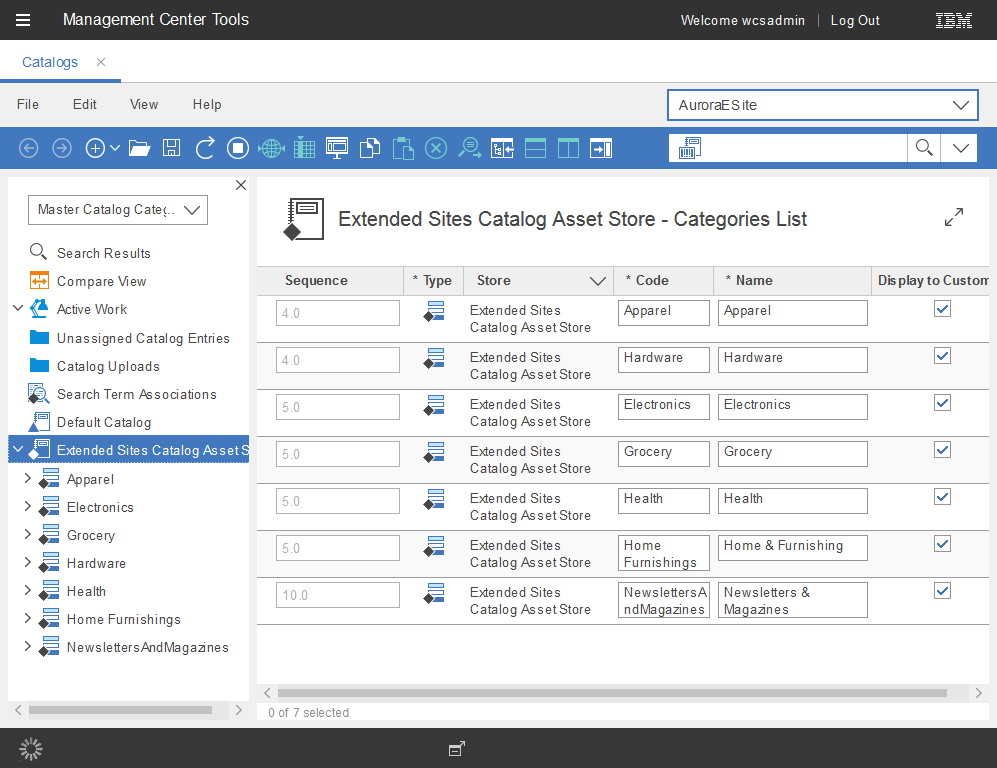Catalogs tool
Use the Catalogs tool in Management Center to manage catalogs, categories, catalog entries, merchandising associations, product attributes, and attachments in the store. The Catalogs tool lets business users create, and manage online catalogs. Catalogs provide a way of organizing the products to sell. You define catalog data in groups of categories and products. Catalog data contains descriptions and pricing information for products and services.The following screen capture provides a quick look at the Catalogs tool. This Categories List view shows all the categories that are created in the Aurora catalog in Management Center:

Overview of the Catalogs tool
Here is a summary of tasks we can perform to manage catalogs for the site:
| Tasks | Details | For more information |
|---|---|---|
| Set or change default catalog | If the store has multiple catalogs, a Category Manager or Product Manager can specify a catalog to use as a default catalog. Selecting a default catalog ensures that shoppers that visit the store see the default catalog in the storefront. | Setting the default catalog |
| Browse, create, change, and delete categories in the master catalog | The Category Manager manages the category hierarchy by creating, modifying, and deleting categories. The category hierarchy organizes products or services that are offered by the store. | Manage categories |
| The Category Manager can also create versions of categories. | Manage category versions | |
| The Category Manager can also specify which attributes are displayed as a facet in the storefront category left sidebar. | Manage facets | |
| Create, change, and delete catalog entries in the master catalog | The Category Manager or Product
Manager can organize bundles and kits in the catalog hierarchy. Category Manager or Product
Manager can create and change bundles and
kits to determine the best way to sell them in the store.
TheCategory Manager or Product Manager can create products available for recurring orders and subscriptions. | Manage catalog entries Manage products Manage SKUs Manage kits |
|
The Category Manager or Product Manager can also create versions of products, SKUs, bundles, and kits. | Manage product versions Manage SKU versions Manage bundle and kit versions | |
| Change, sequence, update, assign, and remove attribute dictionary attributes and values. | The Category Manager or Product
Manager can determine the best way to display, price, and sell products in the online store, including assigning
or changing product attributes such as color or size.
Specify that an attribute dictionary attribute is for use in faceted navigation and can be located with search-based navigation. | Use the attribute dictionary |
| The Category Manager or Product Manager can group attributes with attribute folders can improve organizing the attribute dictionary. | Organizing attribute dictionary attributes with folders | |
| Create, change, and delete sales catalogs and sales categories, and assign catalog entries to sales categories. | The Category Manager or Product Manager manages the category hierarchy by creating, modifying, and deleting categories in sales catalogs. A sales catalog has a flexible display structure that can associate products to more than one category, to suit the requirements of the store. | Manage sales catalogs |
| The Category Manager can also create versions of sales catalogs. | Manage sales catalog versions | |
| The Category Manager or Product Manager can add catalog entries to multiple sales categories simultaneously. In previous releases, catalog entries could be added to a single sales category at a time. | Adding catalog entries to multiple sales categories | |
| The Category Manager or Product Manager can create rule-based sales categories. Rule-based sales categories are a type of sales category that uses a search-based, user-defined rule with WebSphere Commerce search to find and automatically assign catalog entries to the category. | Manage rule-based sales categories | |
| Create, change, and delete merchandising associations | The Product Manager can find, list, create, and change merchandising associations (such as up-sells or cross-sells). | Manage merchandising associations |
| View, find, browse, and associate assets to the catalog | A catalog asset is a managed file, URL, or attachment associated with a catalog entry. For example, an image that shows an alternative view of a product, or a PDF document. In the Catalogs tool, we can associate assets with a specified usage to a sales catalog, categories, or catalog entries. | Manage catalog assets |
| Preview catalog information about store pages | View the effect of catalog content you create on the store pages before they
go live into production. Options include previewing the store:
We can also use the store preview to determine where on the store pages the catalog content is located. | Previewing a store |
| International | Create international catalogs. Create multilingual and multi-currency master and sales catalogs. | Creating a globalized catalog |
| Improve search results on the site | Manage synonyms and replacement search terms, and link search terms with landing pages. Add metadata such as page titles, page descriptions, and image alt text. |
Improving search results on the site using SEO Improving storefront search results using search term associations |
Related tasks
Creating attributes in the attribute dictionary
Manage faceted navigation attributes in categories
Working with catalogs
Manage sales catalogs
Related reference
Default and hidden fields